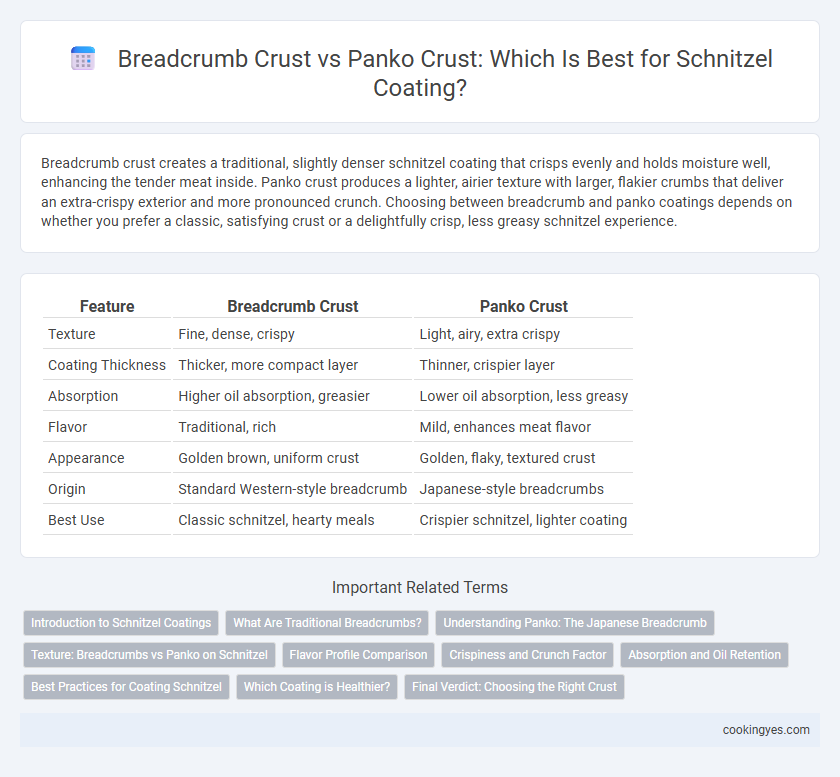Breadcrumb crust creates a traditional, slightly denser schnitzel coating that crisps evenly and holds moisture well, enhancing the tender meat inside. Panko crust produces a lighter, airier texture with larger, flakier crumbs that deliver an extra-crispy exterior and more pronounced crunch. Choosing between breadcrumb and panko coatings depends on whether you prefer a classic, satisfying crust or a delightfully crisp, less greasy schnitzel experience.
Table of Comparison
| Feature | Breadcrumb Crust | Panko Crust |
|---|---|---|
| Texture | Fine, dense, crispy | Light, airy, extra crispy |
| Coating Thickness | Thicker, more compact layer | Thinner, crispier layer |
| Absorption | Higher oil absorption, greasier | Lower oil absorption, less greasy |
| Flavor | Traditional, rich | Mild, enhances meat flavor |
| Appearance | Golden brown, uniform crust | Golden, flaky, textured crust |
| Origin | Standard Western-style breadcrumb | Japanese-style breadcrumbs |
| Best Use | Classic schnitzel, hearty meals | Crispier schnitzel, lighter coating |
Introduction to Schnitzel Coatings
Traditional breadcrumb crust provides a classic, denser coating for schnitzel, offering a familiar texture and flavor profile. Panko crust uses Japanese-style breadcrumbs that create a lighter, crispier, and airier coating, enhancing the schnitzel's crunch without absorbing excess oil. Choosing between breadcrumb and panko coatings influences the overall mouthfeel and juiciness of the schnitzel, tailoring the dish to specific culinary preferences.
What Are Traditional Breadcrumbs?
Traditional breadcrumbs are finely ground bread crumbs that create a dense, uniform crust when coating schnitzel, offering a classic texture and flavor. These breadcrumbs absorb oil evenly during frying, resulting in a golden-brown, crispy exterior while maintaining moisture inside the meat. Compared to panko, traditional breadcrumbs provide a more compact and smooth coating essential for authentic schnitzel preparation.
Understanding Panko: The Japanese Breadcrumb
Panko is a Japanese breadcrumb known for its light, airy texture and larger, flakier crumbs compared to traditional European breadcrumbs. This unique structure creates a crispier, crunchier schnitzel coating that absorbs less oil, resulting in a lighter, less greasy dish. Its porous, coarse consistency allows for an even, golden-brown crust, making panko an ideal choice for achieving the perfect schnitzel crust.
Texture: Breadcrumbs vs Panko on Schnitzel
Traditional breadcrumbs create a denser, crisp crust on schnitzel, delivering a more uniform and finely textured coating. Panko crumbs, originating from Japanese cuisine, provide a lighter, airier crunch with larger, flakier particles that result in a crispier, less oily schnitzel crust. The choice between breadcrumbs and panko significantly affects the schnitzel's texture, with breadcrumbs offering a hearty bite and panko enhancing crispness and lightness.
Flavor Profile Comparison
Traditional breadcrumb crusts offer a rich, buttery flavor with a subtle toasted note that enhances the schnitzel's savory taste. Panko crusts provide a lighter, crispier texture with a milder flavor, allowing the meat's natural flavors to shine without overwhelming the palate. Both coatings contribute distinct flavor profiles, where breadcrumb crusts impart a heartier taste and panko crusts deliver a delicate crunch and cleaner flavor experience.
Crispiness and Crunch Factor
Panko crusts create a lighter, airier coat for schnitzel, delivering an exceptionally crispy texture and superior crunch factor compared to traditional breadcrumb crusts. Traditional breadcrumbs absorb more oil and moisture, resulting in a denser, less crunchy schnitzel coating. For those seeking maximum crispiness and a flakier bite, panko breadcrumbs provide a distinct advantage in schnitzel preparation.
Absorption and Oil Retention
Panko crusts absorb less oil than traditional breadcrumb coatings, resulting in a lighter, crispier schnitzel with reduced greasiness. Their coarser texture creates larger air pockets that prevent excessive oil retention during frying, enhancing overall crunchiness. Conversely, standard breadcrumbs tend to soak up more oil, leading to a denser, heavier crust with higher fat content.
Best Practices for Coating Schnitzel
Using panko crust for schnitzel coating creates a lighter, crunchier texture compared to traditional breadcrumb crust, enhancing the overall eating experience. Best practices include pressing the coating firmly to adhere evenly and ensuring the schnitzel is patted dry before dredging in flour, egg wash, and coating to prevent sogginess. Opting for panko allows for better oil drainage during frying, leading to a crispier, less greasy schnitzel.
Which Coating is Healthier?
Regular breadcrumb crusts often contain more preservatives and have a finer texture, leading to higher oil absorption during frying, which increases calorie content. Panko crusts are made from crustless white bread and have a lighter, airier texture that absorbs less oil, making schnitzel coated with panko generally lower in fat and calories. Choosing panko crusts can contribute to a healthier schnitzel by reducing overall fat intake and promoting a crispier texture without excessive greasiness.
Final Verdict: Choosing the Right Crust
Panko crust offers a lighter, crunchier texture for schnitzel, enhancing the dish's crispiness without absorbing excess oil. Traditional breadcrumb crusts provide a denser, more uniform coating that retains moisture and adds a classic flavor profile. For a crispy, airy schnitzel, panko is ideal; for a hearty, traditional bite, standard breadcrumbs remain the preferred choice.
Breadcrumb crust vs Panko crust for schnitzel coating Infographic

 cookingyes.com
cookingyes.com